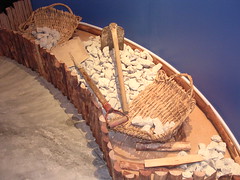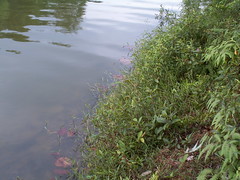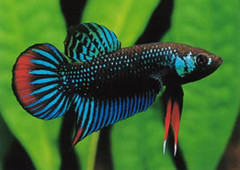about the Grassroots Heritage Centre, I decided to pay a visit the other day at lunch time. As June mentioned, there were lots of useful information about the history of community centres in Singapore for the past 40 years. But I confess I did not pay much attention. Instead, I was excited to see many familiar objects which brought back memories.
The first object that caught my attention was the rattan basket or what we called ‘punki’ in Hokkien. (sorry I do not know the correct name in English). I have not seen this type of rattan punki for a long time. Nowadays, they are all made of plastic and black in colour.

To me the humble punki is a symbol of toil as well as fun. Toil because it reminds me of the tough defence exercises in the army where we had to dig trenches and moved earth with it. Fun because we used to catch fighting fishes from the nearby ponds with it during our kampong days.
As most of the NS boys in Singapore are familiar with the former activity, I will limit this post to sharing about how we used the punki for one of the most enjoyable activities of my childhood.
To catch a fighting fish, you must first locate a suitable site. We usually look for patches of grass or vegetation on the edge of the pond; like the one you see in the picture below (taken at MacRitchie Reservoir), but our grass was taller and the water dirtier. It’s strange how this instinct stays with you all your life. Every time I come across a lake or pond like this, my mind immediately asks; “Are there any fighting fishes here?”

Next you wade quietly to the knee-deep, murky water in front of the patch and plunged in the punki. Immediately, use one hand to beat around the bush, literally, to chase the fishes into your punki, whilst steadying it with the other hand. After that, you raise the punki in eager anticipation. What a thrill it was to see a brightly-coloured, struggling male fighting fish in your punki. However, we occasionally get a rude shock when we see a huge hairy spider scurrying around instead.
The kind of fighting fish we caught were quite different from the ones you see in the aquariums. Those they sell in the aquariums are Siamese fighting fish with bigger, more elegant fins and tails. Ours had smaller fins and tail. They are called betta imbellis, so I learned.

We would put our precious catch in tin cans and bring them home and transfer them to glass Horlicks bottles together with some water plants, usually the hydrilla, and keep them in a dark area, such as (don’t laugh) under our beds, to let them regain their bright colours.
What do we feed them? We usually catch tubifex worms from the nearby Kallang River. How? Please read my earlier story, ( Our Kampong). Alternatively, we use a spoon to scoop mosquito larvae, which were in ample supply, from nearby drains.
Then comes the cruel part where we would let our fishes fight by putting them into a bigger bottle. I am glad that kids nowadays are not so cruel.
This is a photo of me and my younger brother taken in the early 60's. Do you see the pond on our left? On our right is another pond where we catch the fighting fishes. I figure this spot is now right smack on the CTE.
Besides the punki, I also saw some other familiar objects like wooden badminton rackets and a mock-up of the community centre. I will blog about these another time.






18 comments:
I, cockroach never went fishing before. :(
I usually bought my fighting fishes from the roadside aquarium in Short Street where my primary school was located. They were of the same type as that shown in your photo. Can't remember how much they cost, probably not more than 10 cents a fish.
The reason why I had to buy them and not catch them was because I was staying in an SIT flat and not a kampong. However, I remember catching fishes in the nearby Stamford Canal. I had to wade in the knee-deep murky waters like what you have described here but I didn't catch any fighting fishes, only longkang fishes. (These are guppy-like fishes but have smaller tails and are less colourful. You can buy these fishes from the aquarium nowadays at about 20 for $1. People use them as fish feed for bigger fishes like the Arowana.)
Now the Stamford Canal has been covered up but I think that it should still be running underground near where the SMU now stands. Anyone can confirm this?
I remember PM Lee Hsien Loong talking about how he used to catch longkang guppies as a kid. I guess, like you, he too missed out on fighting fishes.
I also went around catching fighting fishes describled by Chun See in my kampong in the HIllview Area. I put dried banana leaves into the glass bottles to maintain their beautiful colours.
Talking about fighting fish, I came a cross a pool of dark coloured water in an obscure corner of our kampong. I was thinking instinctively that this place could be a good catch for fighting fish. With a few kampong kids, and a punki in hand, we decided to raid this hidout. True enough, when I lifted the punki up from the depth of the pool, many fighting fish (as good as the ones seen in this blog) were seen trapped inside the trap, jumping about energetically . Imagine the thrill we had out of this escapade.
We gals also catch small colorfull fishes in the lonkang or big drains. We don't fight the fishes but admire them in glass jam or horlicks bottles.
Punki reminds me of workers in the construction industry. I think no pulley those days, the workers use wheelbarrow, a steel barrow which has 2 small wheels with in front another small wheel and they would transport the sand and cement and mix them up with a iron spade with a long wooden handle. Punki are used to carry the sand or stones to the mixing area. Is this correct ?
Today 2006 they have an electrical rod which they dip in the cement and then it will mix all up or the mobile cement mixer comes and on the way the cement is mixing and ready to pour out into the wheel barrow when they reach the construction site.
Bricks are layed one by one. Today just use prefabricated walls. You know why I know so much about construction. Bcos a construction supervisor was after my elder sister and I recieve a train set as a result. Poor guy did not make it with my sister not even one date ? (*-*)
There's no way that the thrill of catching longkang fish can be compared with catching fighting fish.
Looks like the city folks like Victor and Chinatown Boy missed out a lot. No wonder my cousins loved to come and stay over at our place.
Reminds me of a fish farm in Pasir Ris where they allow kids to scoop so called longkang fish for a small fee. But too clean and unrealistic.
*waveS* uncle lam im here!
you dont see mi commenting often here is not because i wasnt here! but because i dont really have constructive things to pen down.. and i dont wish to pen things like "hihi! ya i agree with u!" and thats it.
not really my style (but it is what most youngsters do mostly because they wan readership to their blogs).. so pardon me if I dont comment..
but you can always be assured that i DO read ur blog.. every entry!
Isn't it sad that what the kids in the old days did for free, the kids today have to pay to do at the Pasir Ris Children's Farm which is a really small claustrophobic place and the pathetic little longkang fish there are really difficult to catch by the way.
More Singaporeans should visit Malaysia for the kampong life there, not just shopping in Mega Malls of KL, or pumping up cheaper petrol. Enjoying the rustic life in our neigbouring countries is also a good idea. We should enjoy these activities while still in good physical shape - not until we have to use a 'walking stick'
Actually nowadays still have a lot of longkang fishes to catch. But parents would not allow, let alone encourage their kids to do it (would you Fuzoo?).
Near my place there's a big longkang. My kids caugt some tilapia and catfish there. The tilapias are still happily swimming around our koi pond with the kois. I have also seen 1 man with his young kids. They probably live in the nearby condo.
I didn't even know there were fish in our longkangs. If it doesn't look too dirty, I wouldn't mind going to catch fish there with my kids but I suppose it is dirty, and smelly right? Sounds like some major washing up after that. I think I prefer to catch grasshoppers or other insects, you don't have to get into dirty water to do that.
Aiyah. Scared dirty how to have fun?
I agree with Chun See. I know I may stir up some controversy with what I say here.
My observation is that nowadays, some people of the younger generation may seem to prefer to turn punki into punky (hairstyles), taking only fun but ignoring the toil and indulging in just the fighting while ignoring the fish.
Of course, some parents are also guilty of being over-protective over their children. I am not. But I think my wife is. That automatically makes me one too. (Now this is the real controversy I was talking about.)
My wife also protective but she is strong science/nature person. Even dragged us to Bt Timah Nature Reserve and Kent Ridge Park to look for pitcher plants. (They are protected species in Spore)
We are a product of our environment, both the physical and social. For example, if we are brought up in clean environment, naturally we abhor dirtiness. Similarly, if we have only a kid or two, we will be extremely protective over their safety and well-being (especially when they are doing NS).
Chuck, I understand that old Sea Almond Tree leaves can also do the job - to heal the sick fish that is. For those who don't know, you can find many of these trees along N. Buona Vista Rd near the Civil Service College. They have big leaves.
Never knew that old Sea Almond Tree leaves could heal sick fish. However, to heal my wounded fighting fish, I used to buy medicine from the Chinese medical shops. It consisted of tiny white granite-like stones. Ten cents could buy a small amount wrapped in typical pink paper. You throw a few pieces of these stones into the bottle containing the wounded fighting fish. The stones would settle to the bottom and produce a steady stream of tiny bubbles for a while. In a few days, the fish would have recovered well enough to be ready for yet another fight.
I can't remember what the medicine was called and don't know if it is still available now. Anyone out there also used this medicine before and can refresh my memory?
Post a Comment